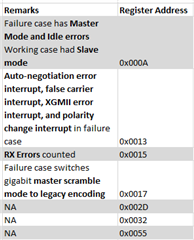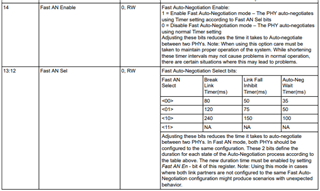Tool/software:
Hi Team,
There is communication problems in the customer system using DP83867IS.
Could you help us?
<Background>
- 1000Mbps communication is assumed with auto-negotiation. 10BASE(Half) and 100BASE(Half) are also advertised.
- Link is established according to the register and LED, however, there is no Ping response from the link partner.
- The customer's system has passed the compliance test, so we checked the registers.
- When we checked Register 0x000A, it is 0x3800 under normal conditions and 0x78FF under communication problems.
- According to this, the local device is a slave under normal conditions, but is a master under communication problems. I think that this is the cause of the communication problems.
- Register 0x0009 is 0x0200, so manual master/slave setting of the local device is disabled.
<Question>
1) What is the difference between the master/slave roles?
2) When and how are the master/slave roles determined?
3) I think that communication problems will occur if the master/slave conflicts with the link partner. Is it possible for a conflict to occur even if manual settings are disabled?
Best Regards,



